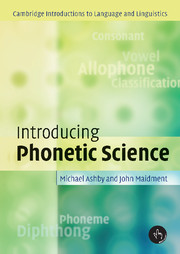1 - Introduction to speech
Published online by Cambridge University Press: 05 June 2012
Summary
CHAPTER OUTLINE
In this chapter you will learn about: the basic distinction between spoken and written language; the ways in which languages of the world are written; the units from which speech is composed: syllables, vowels and consonants; phonetic symbols as a means of representing speech; speech considered as an acoustic signal; the similarities and differences in the speech sounds used in languages of the world.
KEY TERMS
Amplitude
Consonant
International Phonetic Alphabet (IPA)
Loudness
Phonetic symbol
Phonetic transcription
Segment
Syllable
Vowel
Waveform
Writing system
Introduction
The way we usually represent and describe speech depends on a powerful idea that is already known by everyone who is literate in a language with an alphabetic writing system. Human listeners can hear speech as a sequence of sounds, and each sound can be represented by a written mark. In this chapter we look at how this idea can be the basis of a comprehensive system of phonetic symbols, suitable for representing reliably the sounds of any language – and at how this is different from the many existing writing systems for particular languages.
Sounds and symbols
Although there are estimated to be 5,000 to 8,000 languages in the world, each with its own particular selection of sounds, the total number of symbols required to represent all the sounds of these languages is not very large – it is somewhere around two to three hundred. This, of course, is because many sounds are found again and again in languages.
- Type
- Chapter
- Information
- Introducing Phonetic Science , pp. 1 - 20Publisher: Cambridge University PressPrint publication year: 2005



